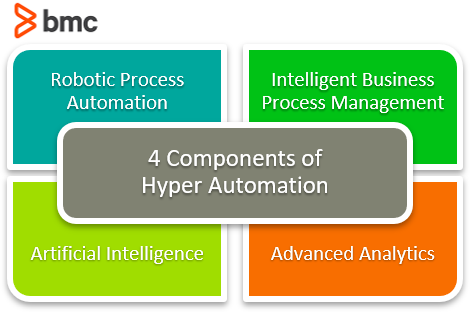Hyper automation is the continuous integration of automation into business operations. It equates to more machines doing more things. It’s the next phase of digital transformation for businesses that are to remain competitive. If you are a digital enterprise, you are already familiar with many of the benefits of automation, like:
- Consistent products and services
- More efficient products and services
- Fewer errors in the supply chain
- More effective use of data throughout the business
Hyper automation takes automation a step further. When businesses achieve hyper automation they achieve high-performance. This makes way for specialists and a revisioning of the human element in business. Here’s the story on hyper automation:
Key components of hyper automation
A report by Gartner says:
“Hyper automation requires selection of the right tools and technologies for the challenge at hand. Understanding the range of automation mechanisms, how they relate to one another, and how they are combined and coordinated, is a major focus for hyper automation.”
Below are some key components of hyper automation that you can apply to your business with the right software. For hyper automation to occur, you must implement these components.

Robotic process automation
Robotic process automation, also known as RPA, is a convenient way to handle data migration when systems don’t have compatible APIs. If you are using at least one old system with outdated APIs, you may run into issues moving structural data from system A to system B. One way to use robotic process automation is to make this process less labor intensive for IT professionals. It can also be used to automate mundane repetitive tasks like data structuring and input.
The above mentioned Gartner report says of RPA:
“Tightly defined integration scripts structure and manipulate data, moving it from one environment to the next. Because the integration is based on interacting with the metadata that drives the screens of existing applications, these tools are usually more accessible to business end-users.”
Intelligent business process management
Intelligent business process management software (iBPMS) is virtual intelligence that coordinates people with machines and other things that make up a technological infrastructure. At the core of iBPMS is modeling and rules to determine the best practices of an organization. Robust APIs make integration easy with many systems.
Gartner says:
“An iBPMS enables citizen developers—most commonly business analysts—and professional developers to collaborate on iterative development and improvement of process and decision models.”
Artificial intelligence
Artificial intelligence (AI) enhances the service process and supply chain with a series of processes like:
- Machine learning
- Intelligent optical character recognition
- Natural language processing (NLP)
Using AI, businesses have begun to rapidly expand their services and service infrastructure. AI digitizes otherwise time-consuming routine processes, like answering basic customer questions or processing a return. Because artificially intelligent machines can do things like recognize faces and voices, machines are capable of performing many tasks. In order to achieve hyper automation, you must strategically employ AI.
Advanced analytics
With tools that allow business leaders to gain deep insights from customer, sales, and operational data, businesses can create KPIs while refining their processes. Digital businesses focus on efficiency by using advanced analytics to understand business trends and expand on them.
What is a DTO?
A digital twin of an organization is sometimes called a DTO. In short, a DTO is a group of software models that make up an organization. It’s necessary to achieve DTO before attempting hyper automation.
DTO is a step in the process of becoming a hyper automated business because it allows companies to model any number of scenarios that could impact their digital business. With a series of software models defined to run scenarios that could occur within the organization, business leaders can better prepare for any potential shortcomings in the business model.
Hyper automation benefits
There are many benefits to perfecting hyper automation of systems and infrastructure. Here are some of the key advantages to adopting this approach:
Enabling your workforce
Employees can get more productive work completed because they aren’t focused on the mundane day-to-day tasks. By enabling your workforce with hyper automation, you increase productivity and drive better results. That means companies that successfully employ hyper automation can grow exponentially by reducing the amount of human interaction with mundane tasks, and enabling their workforce to complete tasks of great importance.
Creating upskilled employee base
When employees focus on enabling their workforce to do better, they create a more skilled and competent workforce. When mundane tasks go to machines, employees must specialize. This creates a work environment that is ready to handle a number of activities with expert-level support. Businesses gain competence and authority when they upskill their employee base with hyper automation.
Return on Investment
With access to important analytics data, businesses can ensure they deliver on return on investment. ROI is a key metric for all businesses because it tells you that you are making money on sales and marketing initiatives. Return on investment is the single most important metric to determine if marketing efforts are impacting the business in a positive way. That’s why achieving a better ROI is an important goal of hyper automation.
Integrating software and processes
Seamless communication between on-premise infrastructure and data storage allows systems to communicate effortlessly, ensuring all essential systems have access to the same centralized data. In today’s enterprise infrastructure businesses practice hybrid cloud and/or multi-cloud infrastructures where integration is an essential part of the efficiency process.
Increasing business agility
Business agility is the principle that allows businesses to grow and change with boundless scalability. When you hyper automate your business, you increase agility because you assign basic tasks to the AI, allowing specialists to handle only the most important escalations.
Improving machine learning
Today’s technology allows artificially intelligent machines to learn where the “Submit” button is on a website, and how to press it, no matter where the button is found on a page. Additionally, machine learning can be trained to recognize things like voices or facial expressions. In this age, machine learning can benefit a business in many ways.
Optimizing KPIs
Most importantly, businesses must optimize key performance indicators, or KPIs. These are metrics that tell business leaders how they are performing against established goals. When routine tasks are removed from the parts of the service cycle that require human interaction, companies can improve their delivery metrics and optimize important KPIs.
Additional resources
For more on this topic, explore these resources:







